Detailed Financial Analysis: Viability of a Chocolate Retail Business
VerifiedAdded on 2023/06/03
|30
|8007
|477
Case Study
AI Summary
This case study provides a comprehensive financial analysis of a proposed chocolate retail business in Norway. It includes an assessment of initial investment requirements, assumptions, breakeven analysis, forecasted income statement, balance sheet, and cash flow statement. Furthermore, a discounted cash flow analysis and sensitivity analysis are performed to evaluate the project's financial viability. The analysis helps determine whether the business plan is feasible and provides recommendations for Uncle Benjamin to proceed, considering factors such as import costs, sales volume, and market conditions. The report aims to equip the business owner with the necessary insights to make informed decisions regarding the financial sustainability of the chocolate retail venture.
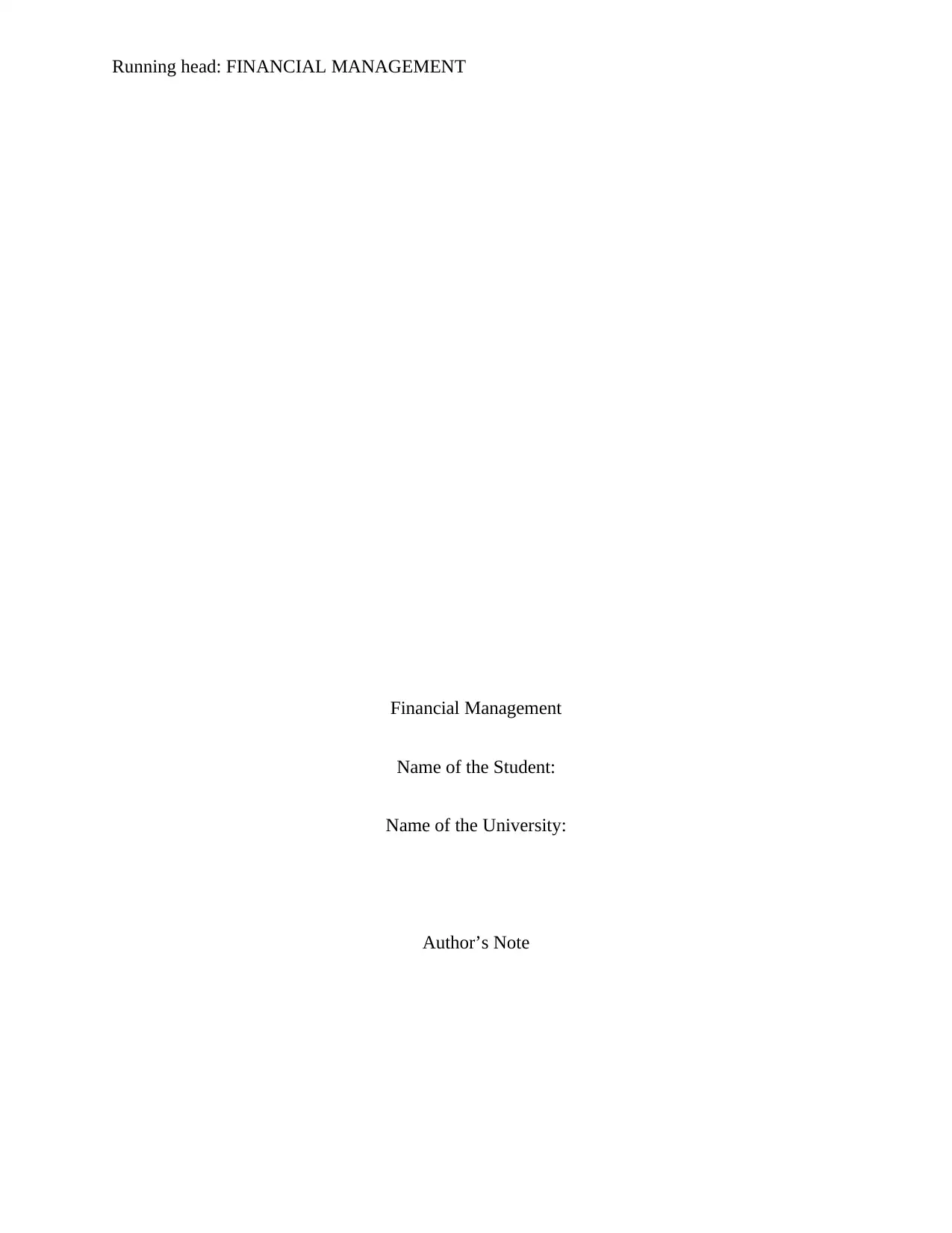
Running head: FINANCIAL MANAGEMENT
Financial Management
Name of the Student:
Name of the University:
Author’s Note
Financial Management
Name of the Student:
Name of the University:
Author’s Note
Paraphrase This Document
Need a fresh take? Get an instant paraphrase of this document with our AI Paraphraser
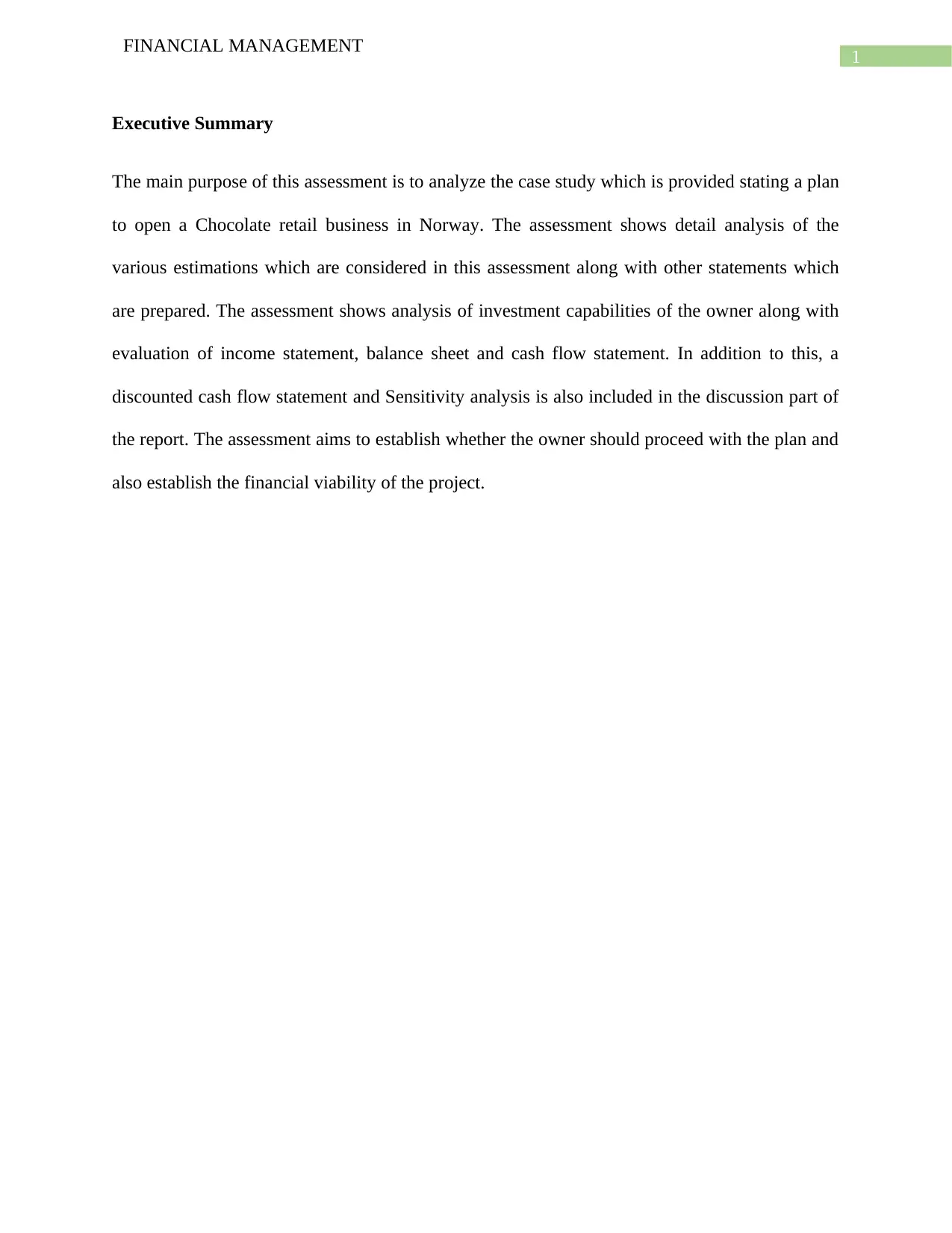
1
FINANCIAL MANAGEMENT
Executive Summary
The main purpose of this assessment is to analyze the case study which is provided stating a plan
to open a Chocolate retail business in Norway. The assessment shows detail analysis of the
various estimations which are considered in this assessment along with other statements which
are prepared. The assessment shows analysis of investment capabilities of the owner along with
evaluation of income statement, balance sheet and cash flow statement. In addition to this, a
discounted cash flow statement and Sensitivity analysis is also included in the discussion part of
the report. The assessment aims to establish whether the owner should proceed with the plan and
also establish the financial viability of the project.
FINANCIAL MANAGEMENT
Executive Summary
The main purpose of this assessment is to analyze the case study which is provided stating a plan
to open a Chocolate retail business in Norway. The assessment shows detail analysis of the
various estimations which are considered in this assessment along with other statements which
are prepared. The assessment shows analysis of investment capabilities of the owner along with
evaluation of income statement, balance sheet and cash flow statement. In addition to this, a
discounted cash flow statement and Sensitivity analysis is also included in the discussion part of
the report. The assessment aims to establish whether the owner should proceed with the plan and
also establish the financial viability of the project.
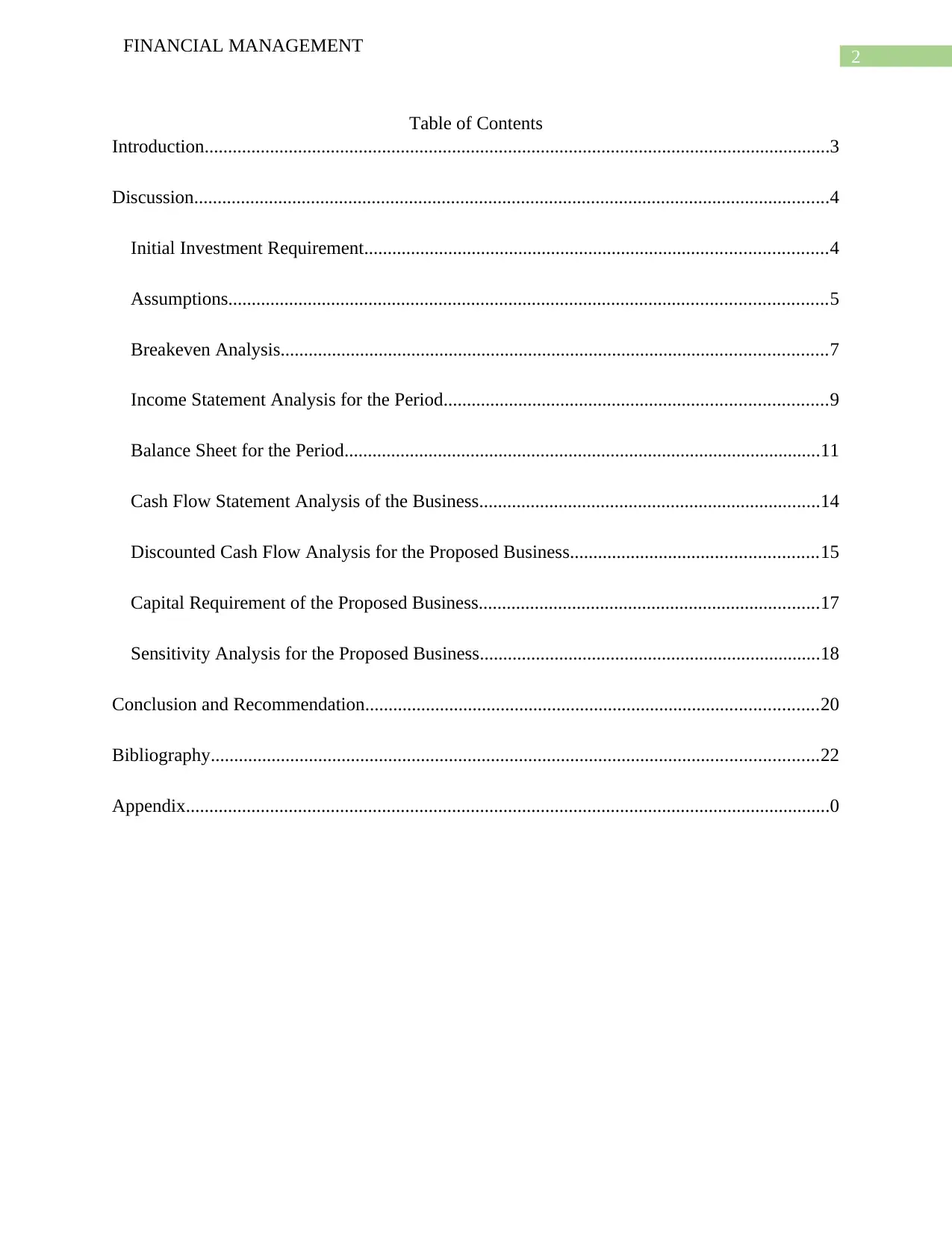
2
FINANCIAL MANAGEMENT
Table of Contents
Introduction......................................................................................................................................3
Discussion........................................................................................................................................4
Initial Investment Requirement...................................................................................................4
Assumptions................................................................................................................................5
Breakeven Analysis.....................................................................................................................7
Income Statement Analysis for the Period..................................................................................9
Balance Sheet for the Period......................................................................................................11
Cash Flow Statement Analysis of the Business.........................................................................14
Discounted Cash Flow Analysis for the Proposed Business.....................................................15
Capital Requirement of the Proposed Business.........................................................................17
Sensitivity Analysis for the Proposed Business.........................................................................18
Conclusion and Recommendation.................................................................................................20
Bibliography..................................................................................................................................22
Appendix..........................................................................................................................................0
FINANCIAL MANAGEMENT
Table of Contents
Introduction......................................................................................................................................3
Discussion........................................................................................................................................4
Initial Investment Requirement...................................................................................................4
Assumptions................................................................................................................................5
Breakeven Analysis.....................................................................................................................7
Income Statement Analysis for the Period..................................................................................9
Balance Sheet for the Period......................................................................................................11
Cash Flow Statement Analysis of the Business.........................................................................14
Discounted Cash Flow Analysis for the Proposed Business.....................................................15
Capital Requirement of the Proposed Business.........................................................................17
Sensitivity Analysis for the Proposed Business.........................................................................18
Conclusion and Recommendation.................................................................................................20
Bibliography..................................................................................................................................22
Appendix..........................................................................................................................................0
⊘ This is a preview!⊘
Do you want full access?
Subscribe today to unlock all pages.

Trusted by 1+ million students worldwide
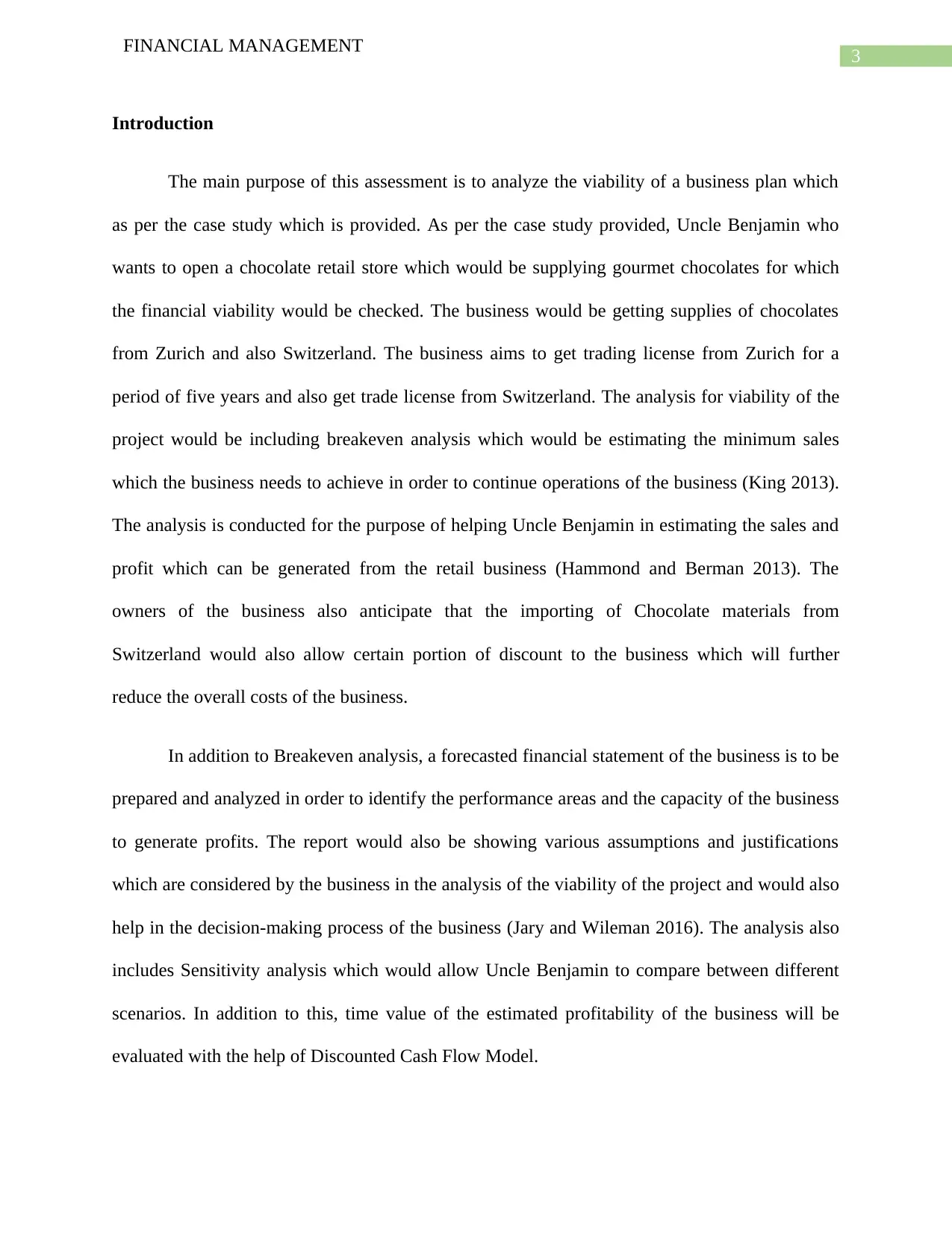
3
FINANCIAL MANAGEMENT
Introduction
The main purpose of this assessment is to analyze the viability of a business plan which
as per the case study which is provided. As per the case study provided, Uncle Benjamin who
wants to open a chocolate retail store which would be supplying gourmet chocolates for which
the financial viability would be checked. The business would be getting supplies of chocolates
from Zurich and also Switzerland. The business aims to get trading license from Zurich for a
period of five years and also get trade license from Switzerland. The analysis for viability of the
project would be including breakeven analysis which would be estimating the minimum sales
which the business needs to achieve in order to continue operations of the business (King 2013).
The analysis is conducted for the purpose of helping Uncle Benjamin in estimating the sales and
profit which can be generated from the retail business (Hammond and Berman 2013). The
owners of the business also anticipate that the importing of Chocolate materials from
Switzerland would also allow certain portion of discount to the business which will further
reduce the overall costs of the business.
In addition to Breakeven analysis, a forecasted financial statement of the business is to be
prepared and analyzed in order to identify the performance areas and the capacity of the business
to generate profits. The report would also be showing various assumptions and justifications
which are considered by the business in the analysis of the viability of the project and would also
help in the decision-making process of the business (Jary and Wileman 2016). The analysis also
includes Sensitivity analysis which would allow Uncle Benjamin to compare between different
scenarios. In addition to this, time value of the estimated profitability of the business will be
evaluated with the help of Discounted Cash Flow Model.
FINANCIAL MANAGEMENT
Introduction
The main purpose of this assessment is to analyze the viability of a business plan which
as per the case study which is provided. As per the case study provided, Uncle Benjamin who
wants to open a chocolate retail store which would be supplying gourmet chocolates for which
the financial viability would be checked. The business would be getting supplies of chocolates
from Zurich and also Switzerland. The business aims to get trading license from Zurich for a
period of five years and also get trade license from Switzerland. The analysis for viability of the
project would be including breakeven analysis which would be estimating the minimum sales
which the business needs to achieve in order to continue operations of the business (King 2013).
The analysis is conducted for the purpose of helping Uncle Benjamin in estimating the sales and
profit which can be generated from the retail business (Hammond and Berman 2013). The
owners of the business also anticipate that the importing of Chocolate materials from
Switzerland would also allow certain portion of discount to the business which will further
reduce the overall costs of the business.
In addition to Breakeven analysis, a forecasted financial statement of the business is to be
prepared and analyzed in order to identify the performance areas and the capacity of the business
to generate profits. The report would also be showing various assumptions and justifications
which are considered by the business in the analysis of the viability of the project and would also
help in the decision-making process of the business (Jary and Wileman 2016). The analysis also
includes Sensitivity analysis which would allow Uncle Benjamin to compare between different
scenarios. In addition to this, time value of the estimated profitability of the business will be
evaluated with the help of Discounted Cash Flow Model.
Paraphrase This Document
Need a fresh take? Get an instant paraphrase of this document with our AI Paraphraser
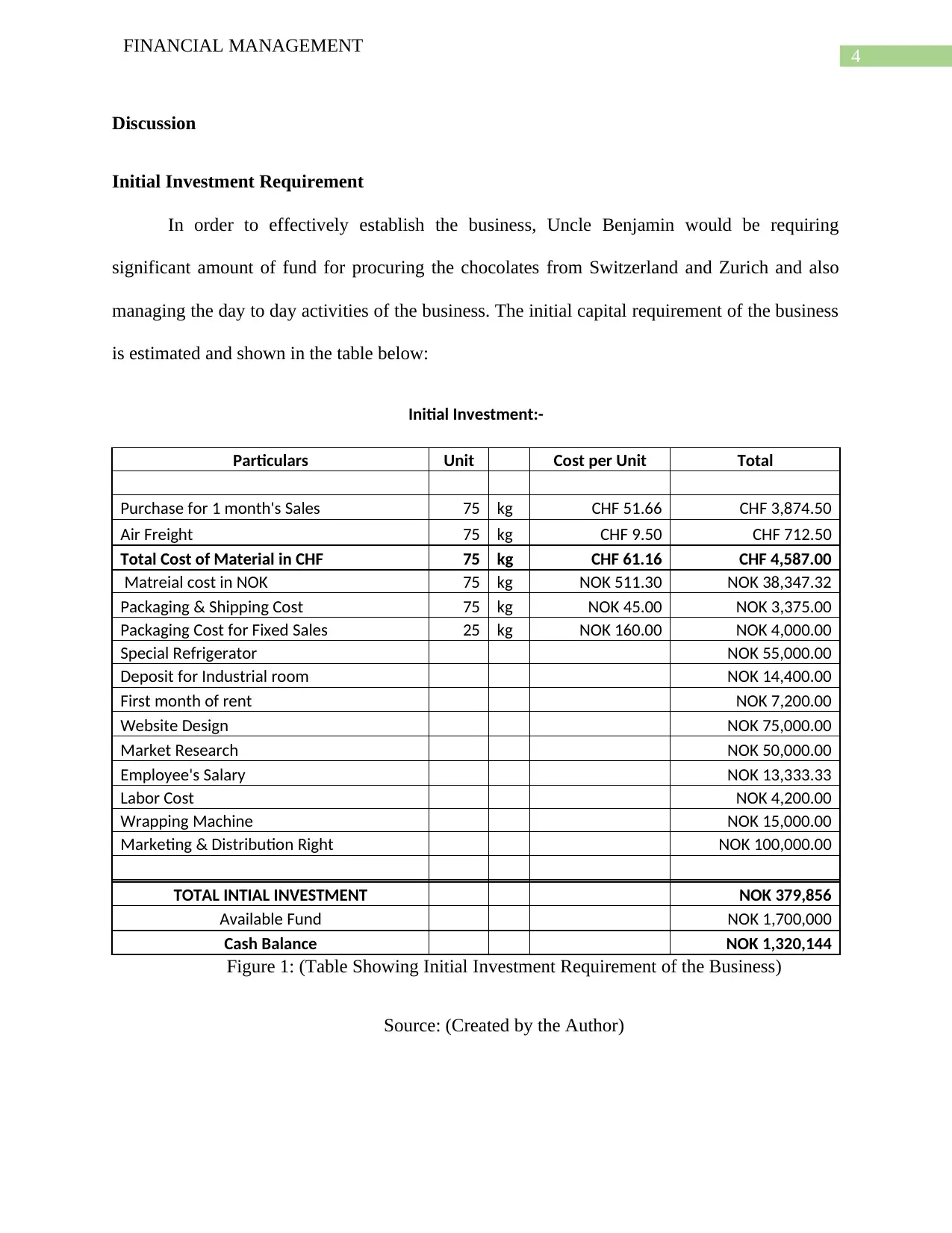
4
FINANCIAL MANAGEMENT
Discussion
Initial Investment Requirement
In order to effectively establish the business, Uncle Benjamin would be requiring
significant amount of fund for procuring the chocolates from Switzerland and Zurich and also
managing the day to day activities of the business. The initial capital requirement of the business
is estimated and shown in the table below:
Initial Investment:-
Particulars Unit Cost per Unit Total
Purchase for 1 month's Sales 75 kg CHF 51.66 CHF 3,874.50
Air Freight 75 kg CHF 9.50 CHF 712.50
Total Cost of Material in CHF 75 kg CHF 61.16 CHF 4,587.00
Matreial cost in NOK 75 kg NOK 511.30 NOK 38,347.32
Packaging & Shipping Cost 75 kg NOK 45.00 NOK 3,375.00
Packaging Cost for Fixed Sales 25 kg NOK 160.00 NOK 4,000.00
Special Refrigerator NOK 55,000.00
Deposit for Industrial room NOK 14,400.00
First month of rent NOK 7,200.00
Website Design NOK 75,000.00
Market Research NOK 50,000.00
Employee's Salary NOK 13,333.33
Labor Cost NOK 4,200.00
Wrapping Machine NOK 15,000.00
Marketing & Distribution Right NOK 100,000.00
TOTAL INTIAL INVESTMENT NOK 379,856
Available Fund NOK 1,700,000
Cash Balance NOK 1,320,144
Figure 1: (Table Showing Initial Investment Requirement of the Business)
Source: (Created by the Author)
FINANCIAL MANAGEMENT
Discussion
Initial Investment Requirement
In order to effectively establish the business, Uncle Benjamin would be requiring
significant amount of fund for procuring the chocolates from Switzerland and Zurich and also
managing the day to day activities of the business. The initial capital requirement of the business
is estimated and shown in the table below:
Initial Investment:-
Particulars Unit Cost per Unit Total
Purchase for 1 month's Sales 75 kg CHF 51.66 CHF 3,874.50
Air Freight 75 kg CHF 9.50 CHF 712.50
Total Cost of Material in CHF 75 kg CHF 61.16 CHF 4,587.00
Matreial cost in NOK 75 kg NOK 511.30 NOK 38,347.32
Packaging & Shipping Cost 75 kg NOK 45.00 NOK 3,375.00
Packaging Cost for Fixed Sales 25 kg NOK 160.00 NOK 4,000.00
Special Refrigerator NOK 55,000.00
Deposit for Industrial room NOK 14,400.00
First month of rent NOK 7,200.00
Website Design NOK 75,000.00
Market Research NOK 50,000.00
Employee's Salary NOK 13,333.33
Labor Cost NOK 4,200.00
Wrapping Machine NOK 15,000.00
Marketing & Distribution Right NOK 100,000.00
TOTAL INTIAL INVESTMENT NOK 379,856
Available Fund NOK 1,700,000
Cash Balance NOK 1,320,144
Figure 1: (Table Showing Initial Investment Requirement of the Business)
Source: (Created by the Author)
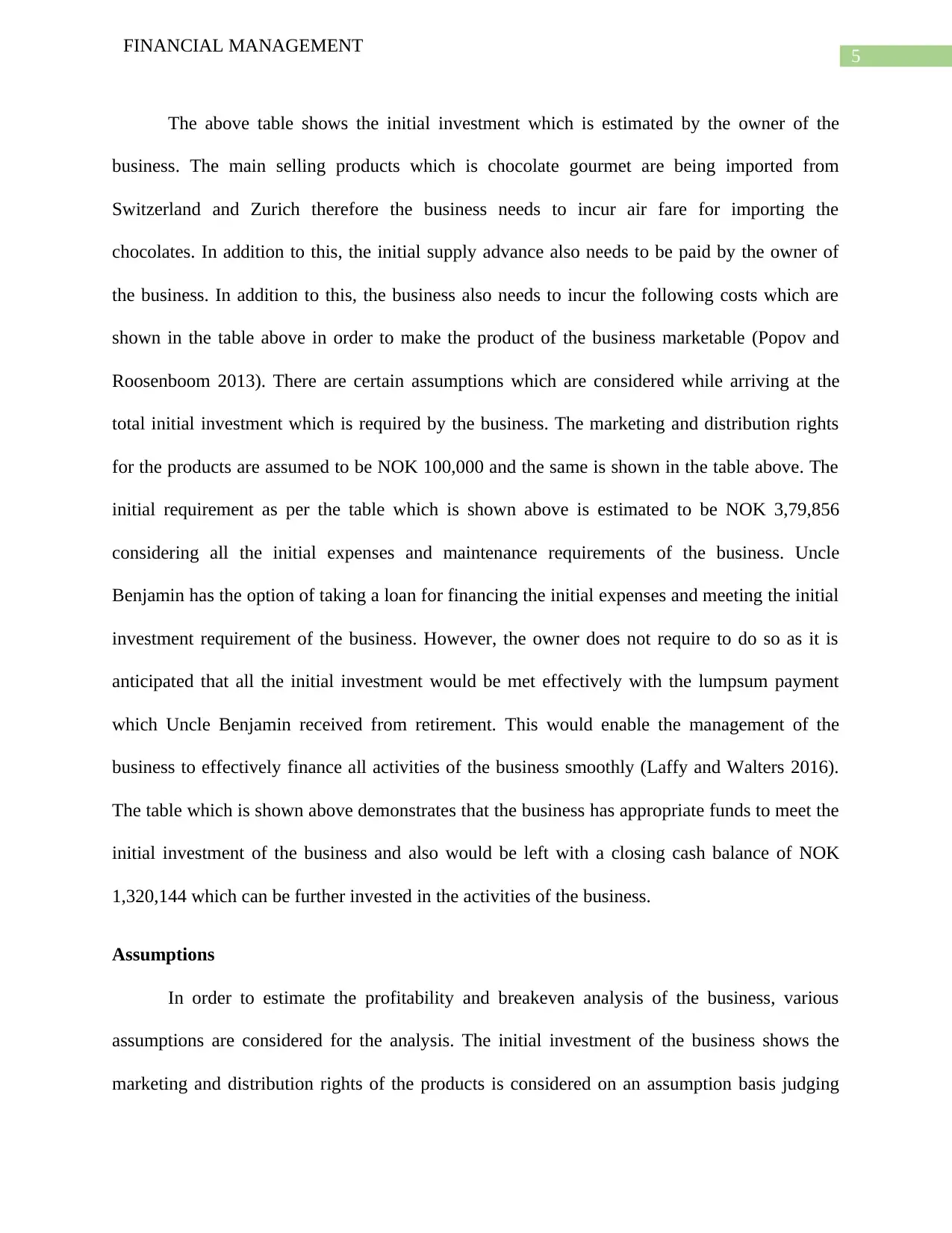
5
FINANCIAL MANAGEMENT
The above table shows the initial investment which is estimated by the owner of the
business. The main selling products which is chocolate gourmet are being imported from
Switzerland and Zurich therefore the business needs to incur air fare for importing the
chocolates. In addition to this, the initial supply advance also needs to be paid by the owner of
the business. In addition to this, the business also needs to incur the following costs which are
shown in the table above in order to make the product of the business marketable (Popov and
Roosenboom 2013). There are certain assumptions which are considered while arriving at the
total initial investment which is required by the business. The marketing and distribution rights
for the products are assumed to be NOK 100,000 and the same is shown in the table above. The
initial requirement as per the table which is shown above is estimated to be NOK 3,79,856
considering all the initial expenses and maintenance requirements of the business. Uncle
Benjamin has the option of taking a loan for financing the initial expenses and meeting the initial
investment requirement of the business. However, the owner does not require to do so as it is
anticipated that all the initial investment would be met effectively with the lumpsum payment
which Uncle Benjamin received from retirement. This would enable the management of the
business to effectively finance all activities of the business smoothly (Laffy and Walters 2016).
The table which is shown above demonstrates that the business has appropriate funds to meet the
initial investment of the business and also would be left with a closing cash balance of NOK
1,320,144 which can be further invested in the activities of the business.
Assumptions
In order to estimate the profitability and breakeven analysis of the business, various
assumptions are considered for the analysis. The initial investment of the business shows the
marketing and distribution rights of the products is considered on an assumption basis judging
FINANCIAL MANAGEMENT
The above table shows the initial investment which is estimated by the owner of the
business. The main selling products which is chocolate gourmet are being imported from
Switzerland and Zurich therefore the business needs to incur air fare for importing the
chocolates. In addition to this, the initial supply advance also needs to be paid by the owner of
the business. In addition to this, the business also needs to incur the following costs which are
shown in the table above in order to make the product of the business marketable (Popov and
Roosenboom 2013). There are certain assumptions which are considered while arriving at the
total initial investment which is required by the business. The marketing and distribution rights
for the products are assumed to be NOK 100,000 and the same is shown in the table above. The
initial requirement as per the table which is shown above is estimated to be NOK 3,79,856
considering all the initial expenses and maintenance requirements of the business. Uncle
Benjamin has the option of taking a loan for financing the initial expenses and meeting the initial
investment requirement of the business. However, the owner does not require to do so as it is
anticipated that all the initial investment would be met effectively with the lumpsum payment
which Uncle Benjamin received from retirement. This would enable the management of the
business to effectively finance all activities of the business smoothly (Laffy and Walters 2016).
The table which is shown above demonstrates that the business has appropriate funds to meet the
initial investment of the business and also would be left with a closing cash balance of NOK
1,320,144 which can be further invested in the activities of the business.
Assumptions
In order to estimate the profitability and breakeven analysis of the business, various
assumptions are considered for the analysis. The initial investment of the business shows the
marketing and distribution rights of the products is considered on an assumption basis judging
⊘ This is a preview!⊘
Do you want full access?
Subscribe today to unlock all pages.

Trusted by 1+ million students worldwide
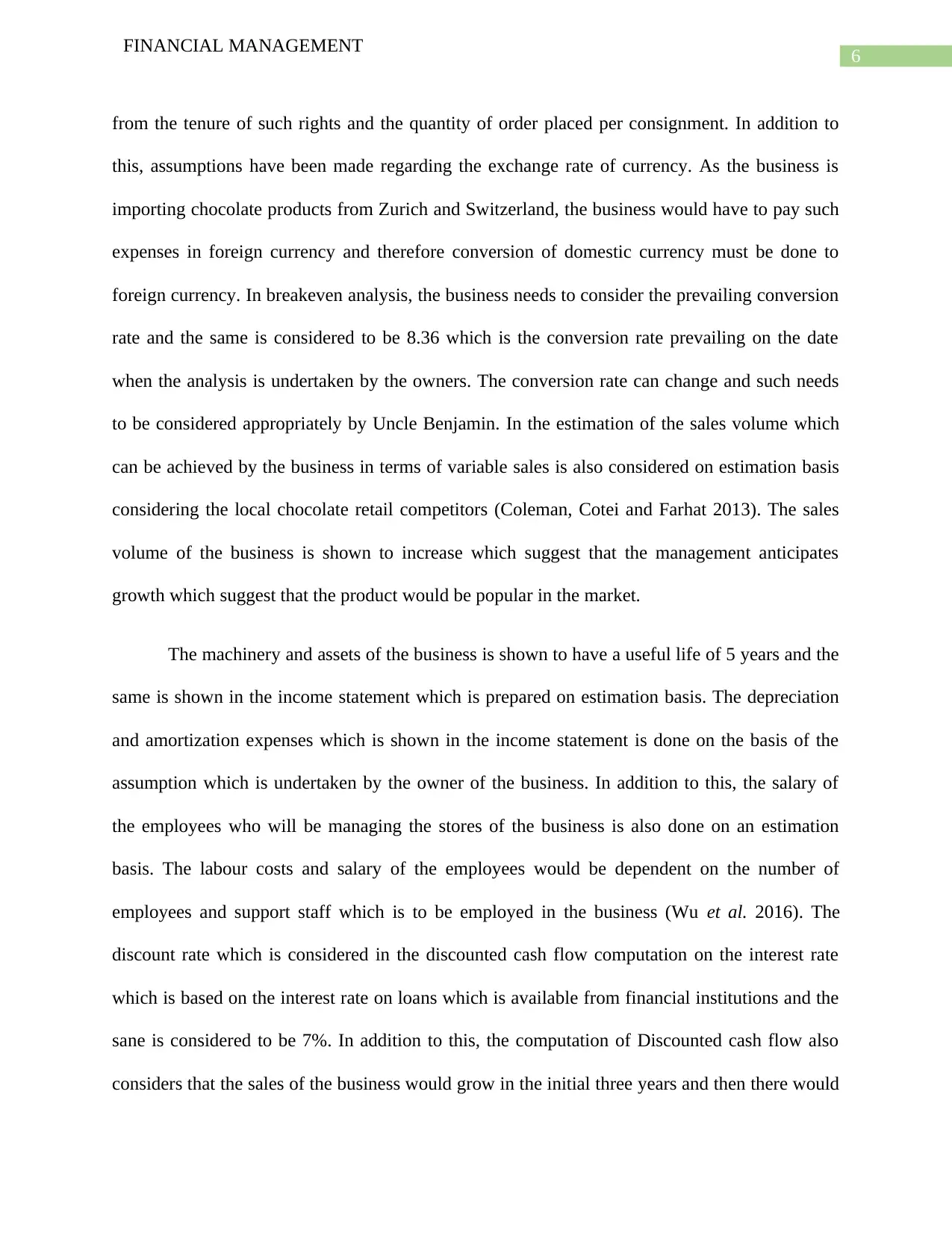
6
FINANCIAL MANAGEMENT
from the tenure of such rights and the quantity of order placed per consignment. In addition to
this, assumptions have been made regarding the exchange rate of currency. As the business is
importing chocolate products from Zurich and Switzerland, the business would have to pay such
expenses in foreign currency and therefore conversion of domestic currency must be done to
foreign currency. In breakeven analysis, the business needs to consider the prevailing conversion
rate and the same is considered to be 8.36 which is the conversion rate prevailing on the date
when the analysis is undertaken by the owners. The conversion rate can change and such needs
to be considered appropriately by Uncle Benjamin. In the estimation of the sales volume which
can be achieved by the business in terms of variable sales is also considered on estimation basis
considering the local chocolate retail competitors (Coleman, Cotei and Farhat 2013). The sales
volume of the business is shown to increase which suggest that the management anticipates
growth which suggest that the product would be popular in the market.
The machinery and assets of the business is shown to have a useful life of 5 years and the
same is shown in the income statement which is prepared on estimation basis. The depreciation
and amortization expenses which is shown in the income statement is done on the basis of the
assumption which is undertaken by the owner of the business. In addition to this, the salary of
the employees who will be managing the stores of the business is also done on an estimation
basis. The labour costs and salary of the employees would be dependent on the number of
employees and support staff which is to be employed in the business (Wu et al. 2016). The
discount rate which is considered in the discounted cash flow computation on the interest rate
which is based on the interest rate on loans which is available from financial institutions and the
sane is considered to be 7%. In addition to this, the computation of Discounted cash flow also
considers that the sales of the business would grow in the initial three years and then there would
FINANCIAL MANAGEMENT
from the tenure of such rights and the quantity of order placed per consignment. In addition to
this, assumptions have been made regarding the exchange rate of currency. As the business is
importing chocolate products from Zurich and Switzerland, the business would have to pay such
expenses in foreign currency and therefore conversion of domestic currency must be done to
foreign currency. In breakeven analysis, the business needs to consider the prevailing conversion
rate and the same is considered to be 8.36 which is the conversion rate prevailing on the date
when the analysis is undertaken by the owners. The conversion rate can change and such needs
to be considered appropriately by Uncle Benjamin. In the estimation of the sales volume which
can be achieved by the business in terms of variable sales is also considered on estimation basis
considering the local chocolate retail competitors (Coleman, Cotei and Farhat 2013). The sales
volume of the business is shown to increase which suggest that the management anticipates
growth which suggest that the product would be popular in the market.
The machinery and assets of the business is shown to have a useful life of 5 years and the
same is shown in the income statement which is prepared on estimation basis. The depreciation
and amortization expenses which is shown in the income statement is done on the basis of the
assumption which is undertaken by the owner of the business. In addition to this, the salary of
the employees who will be managing the stores of the business is also done on an estimation
basis. The labour costs and salary of the employees would be dependent on the number of
employees and support staff which is to be employed in the business (Wu et al. 2016). The
discount rate which is considered in the discounted cash flow computation on the interest rate
which is based on the interest rate on loans which is available from financial institutions and the
sane is considered to be 7%. In addition to this, the computation of Discounted cash flow also
considers that the sales of the business would grow in the initial three years and then there would
Paraphrase This Document
Need a fresh take? Get an instant paraphrase of this document with our AI Paraphraser
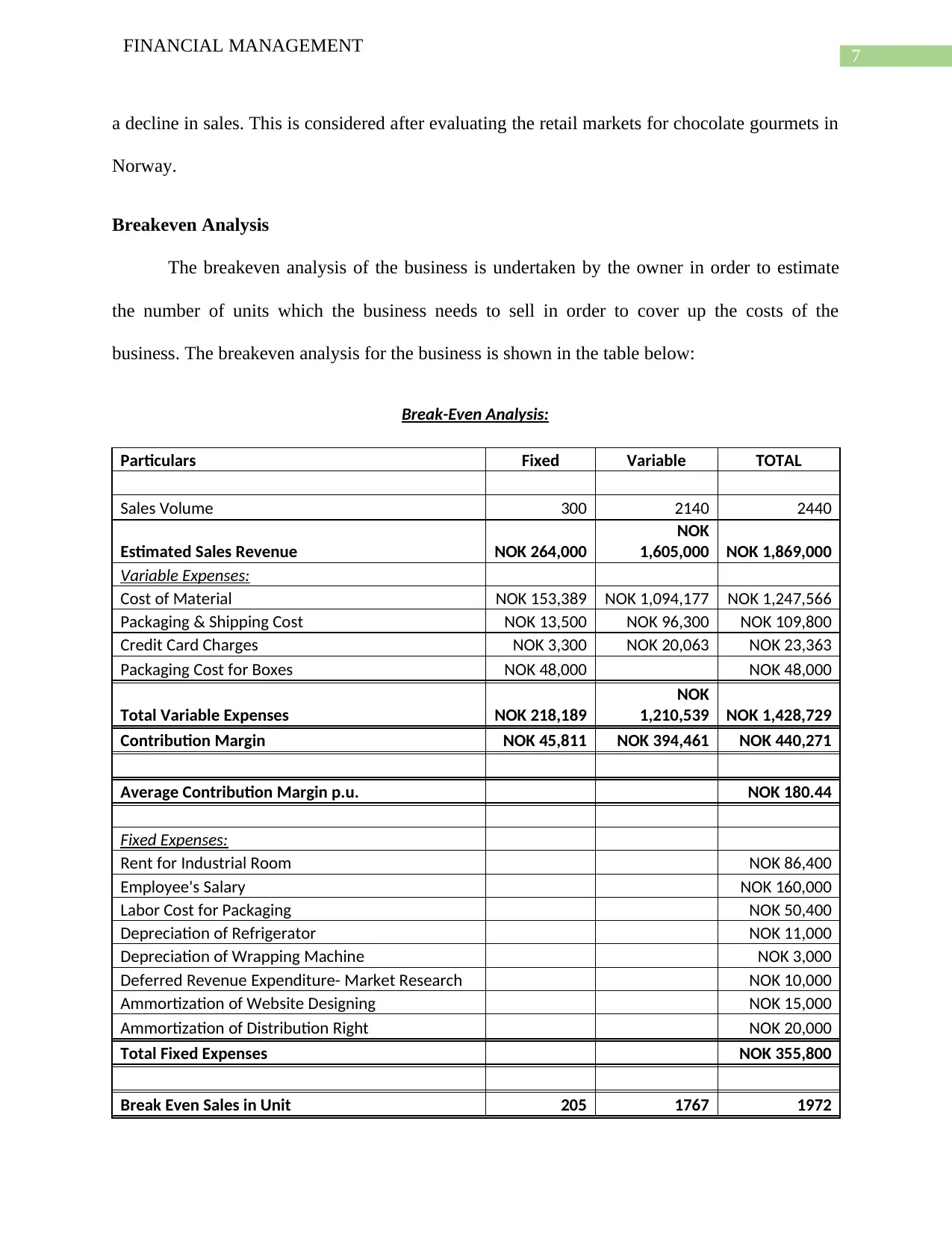
7
FINANCIAL MANAGEMENT
a decline in sales. This is considered after evaluating the retail markets for chocolate gourmets in
Norway.
Breakeven Analysis
The breakeven analysis of the business is undertaken by the owner in order to estimate
the number of units which the business needs to sell in order to cover up the costs of the
business. The breakeven analysis for the business is shown in the table below:
Break-Even Analysis:
Particulars Fixed Variable TOTAL
Sales Volume 300 2140 2440
Estimated Sales Revenue NOK 264,000
NOK
1,605,000 NOK 1,869,000
Variable Expenses:
Cost of Material NOK 153,389 NOK 1,094,177 NOK 1,247,566
Packaging & Shipping Cost NOK 13,500 NOK 96,300 NOK 109,800
Credit Card Charges NOK 3,300 NOK 20,063 NOK 23,363
Packaging Cost for Boxes NOK 48,000 NOK 48,000
Total Variable Expenses NOK 218,189
NOK
1,210,539 NOK 1,428,729
Contribution Margin NOK 45,811 NOK 394,461 NOK 440,271
Average Contribution Margin p.u. NOK 180.44
Fixed Expenses:
Rent for Industrial Room NOK 86,400
Employee's Salary NOK 160,000
Labor Cost for Packaging NOK 50,400
Depreciation of Refrigerator NOK 11,000
Depreciation of Wrapping Machine NOK 3,000
Deferred Revenue Expenditure- Market Research NOK 10,000
Ammortization of Website Designing NOK 15,000
Ammortization of Distribution Right NOK 20,000
Total Fixed Expenses NOK 355,800
Break Even Sales in Unit 205 1767 1972
FINANCIAL MANAGEMENT
a decline in sales. This is considered after evaluating the retail markets for chocolate gourmets in
Norway.
Breakeven Analysis
The breakeven analysis of the business is undertaken by the owner in order to estimate
the number of units which the business needs to sell in order to cover up the costs of the
business. The breakeven analysis for the business is shown in the table below:
Break-Even Analysis:
Particulars Fixed Variable TOTAL
Sales Volume 300 2140 2440
Estimated Sales Revenue NOK 264,000
NOK
1,605,000 NOK 1,869,000
Variable Expenses:
Cost of Material NOK 153,389 NOK 1,094,177 NOK 1,247,566
Packaging & Shipping Cost NOK 13,500 NOK 96,300 NOK 109,800
Credit Card Charges NOK 3,300 NOK 20,063 NOK 23,363
Packaging Cost for Boxes NOK 48,000 NOK 48,000
Total Variable Expenses NOK 218,189
NOK
1,210,539 NOK 1,428,729
Contribution Margin NOK 45,811 NOK 394,461 NOK 440,271
Average Contribution Margin p.u. NOK 180.44
Fixed Expenses:
Rent for Industrial Room NOK 86,400
Employee's Salary NOK 160,000
Labor Cost for Packaging NOK 50,400
Depreciation of Refrigerator NOK 11,000
Depreciation of Wrapping Machine NOK 3,000
Deferred Revenue Expenditure- Market Research NOK 10,000
Ammortization of Website Designing NOK 15,000
Ammortization of Distribution Right NOK 20,000
Total Fixed Expenses NOK 355,800
Break Even Sales in Unit 205 1767 1972
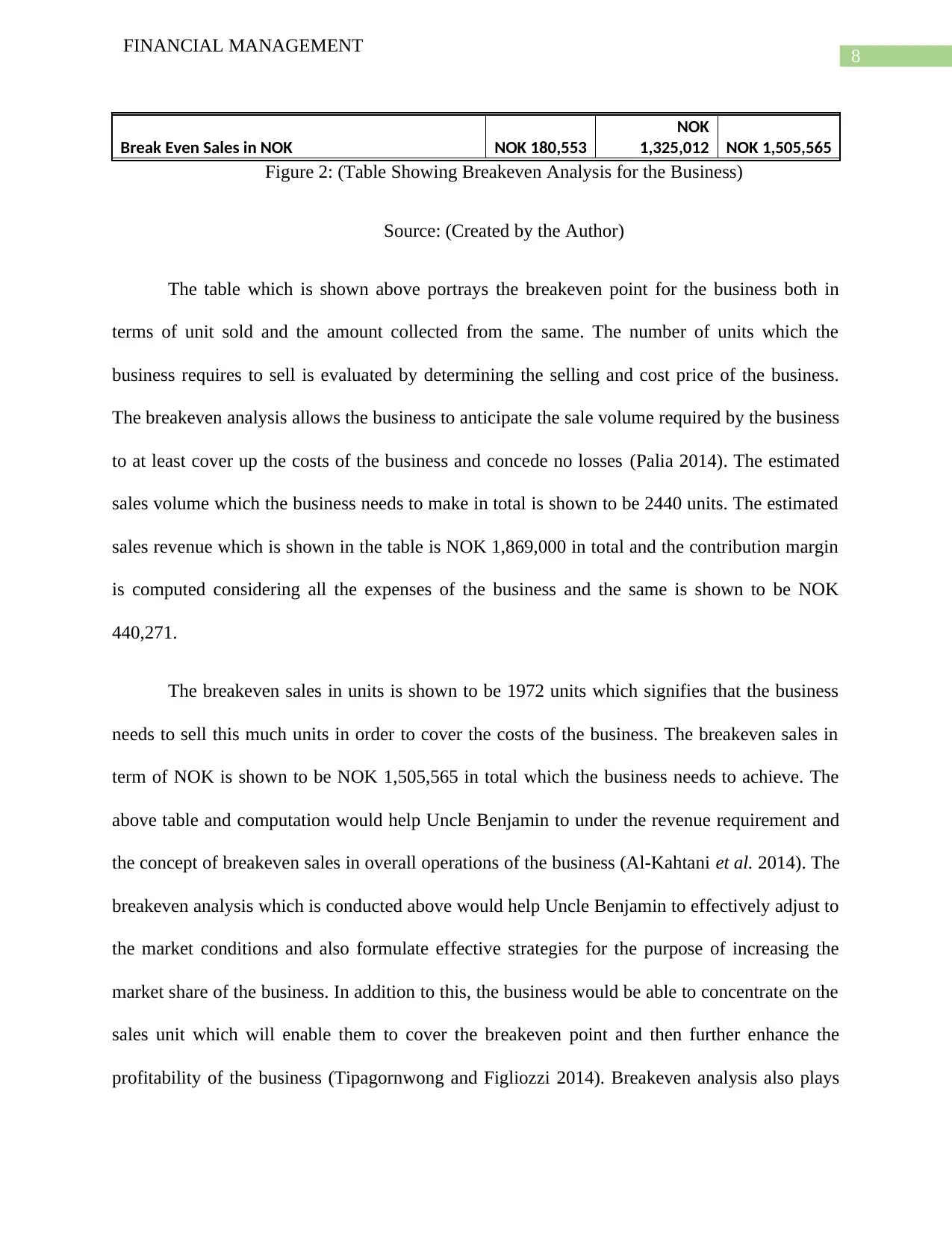
8
FINANCIAL MANAGEMENT
Break Even Sales in NOK NOK 180,553
NOK
1,325,012 NOK 1,505,565
Figure 2: (Table Showing Breakeven Analysis for the Business)
Source: (Created by the Author)
The table which is shown above portrays the breakeven point for the business both in
terms of unit sold and the amount collected from the same. The number of units which the
business requires to sell is evaluated by determining the selling and cost price of the business.
The breakeven analysis allows the business to anticipate the sale volume required by the business
to at least cover up the costs of the business and concede no losses (Palia 2014). The estimated
sales volume which the business needs to make in total is shown to be 2440 units. The estimated
sales revenue which is shown in the table is NOK 1,869,000 in total and the contribution margin
is computed considering all the expenses of the business and the same is shown to be NOK
440,271.
The breakeven sales in units is shown to be 1972 units which signifies that the business
needs to sell this much units in order to cover the costs of the business. The breakeven sales in
term of NOK is shown to be NOK 1,505,565 in total which the business needs to achieve. The
above table and computation would help Uncle Benjamin to under the revenue requirement and
the concept of breakeven sales in overall operations of the business (Al-Kahtani et al. 2014). The
breakeven analysis which is conducted above would help Uncle Benjamin to effectively adjust to
the market conditions and also formulate effective strategies for the purpose of increasing the
market share of the business. In addition to this, the business would be able to concentrate on the
sales unit which will enable them to cover the breakeven point and then further enhance the
profitability of the business (Tipagornwong and Figliozzi 2014). Breakeven analysis also plays
FINANCIAL MANAGEMENT
Break Even Sales in NOK NOK 180,553
NOK
1,325,012 NOK 1,505,565
Figure 2: (Table Showing Breakeven Analysis for the Business)
Source: (Created by the Author)
The table which is shown above portrays the breakeven point for the business both in
terms of unit sold and the amount collected from the same. The number of units which the
business requires to sell is evaluated by determining the selling and cost price of the business.
The breakeven analysis allows the business to anticipate the sale volume required by the business
to at least cover up the costs of the business and concede no losses (Palia 2014). The estimated
sales volume which the business needs to make in total is shown to be 2440 units. The estimated
sales revenue which is shown in the table is NOK 1,869,000 in total and the contribution margin
is computed considering all the expenses of the business and the same is shown to be NOK
440,271.
The breakeven sales in units is shown to be 1972 units which signifies that the business
needs to sell this much units in order to cover the costs of the business. The breakeven sales in
term of NOK is shown to be NOK 1,505,565 in total which the business needs to achieve. The
above table and computation would help Uncle Benjamin to under the revenue requirement and
the concept of breakeven sales in overall operations of the business (Al-Kahtani et al. 2014). The
breakeven analysis which is conducted above would help Uncle Benjamin to effectively adjust to
the market conditions and also formulate effective strategies for the purpose of increasing the
market share of the business. In addition to this, the business would be able to concentrate on the
sales unit which will enable them to cover the breakeven point and then further enhance the
profitability of the business (Tipagornwong and Figliozzi 2014). Breakeven analysis also plays
⊘ This is a preview!⊘
Do you want full access?
Subscribe today to unlock all pages.

Trusted by 1+ million students worldwide
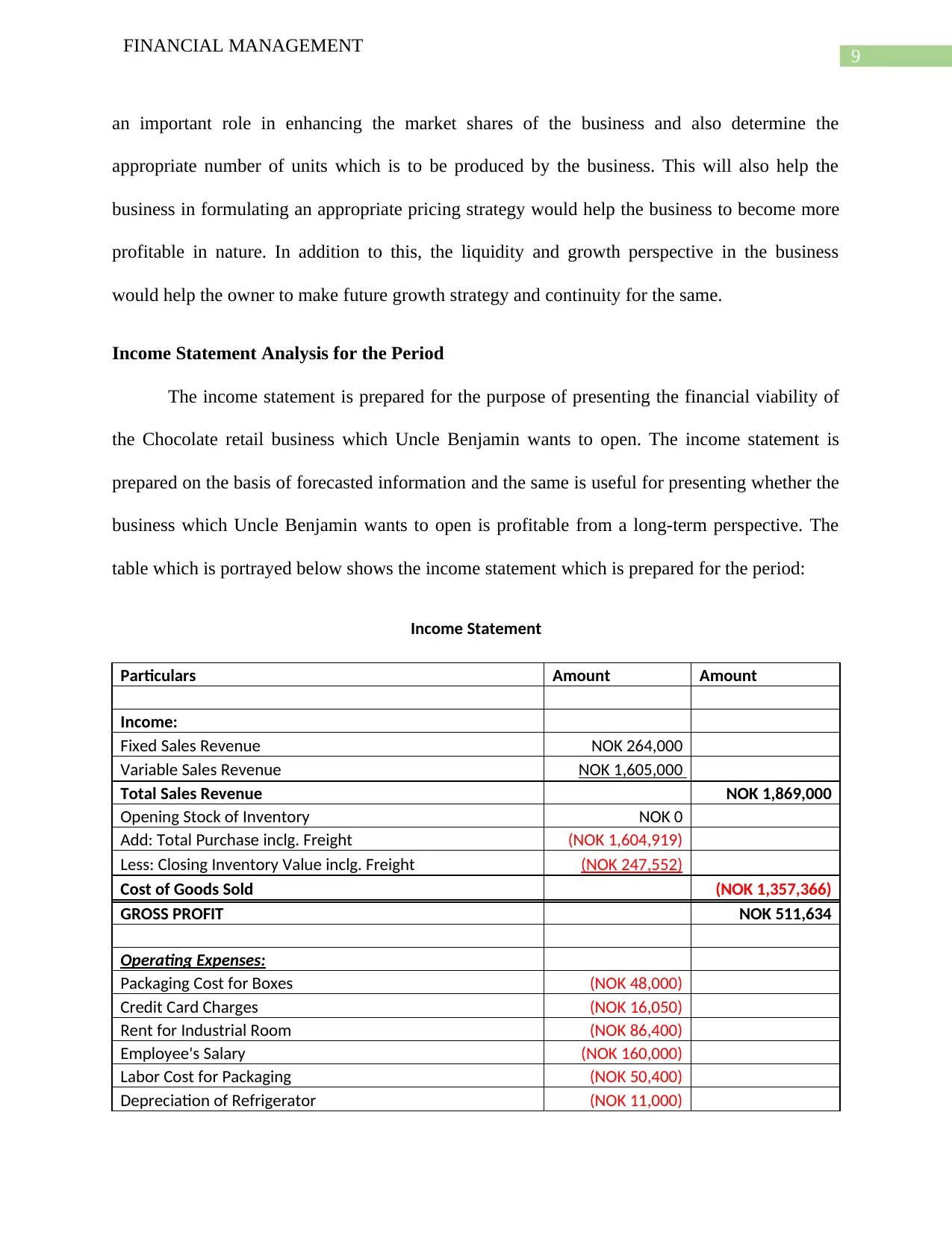
9
FINANCIAL MANAGEMENT
an important role in enhancing the market shares of the business and also determine the
appropriate number of units which is to be produced by the business. This will also help the
business in formulating an appropriate pricing strategy would help the business to become more
profitable in nature. In addition to this, the liquidity and growth perspective in the business
would help the owner to make future growth strategy and continuity for the same.
Income Statement Analysis for the Period
The income statement is prepared for the purpose of presenting the financial viability of
the Chocolate retail business which Uncle Benjamin wants to open. The income statement is
prepared on the basis of forecasted information and the same is useful for presenting whether the
business which Uncle Benjamin wants to open is profitable from a long-term perspective. The
table which is portrayed below shows the income statement which is prepared for the period:
Income Statement
Particulars Amount Amount
Income:
Fixed Sales Revenue NOK 264,000
Variable Sales Revenue NOK 1,605,000
Total Sales Revenue NOK 1,869,000
Opening Stock of Inventory NOK 0
Add: Total Purchase inclg. Freight (NOK 1,604,919)
Less: Closing Inventory Value inclg. Freight (NOK 247,552)
Cost of Goods Sold (NOK 1,357,366)
GROSS PROFIT NOK 511,634
Operating Expenses:
Packaging Cost for Boxes (NOK 48,000)
Credit Card Charges (NOK 16,050)
Rent for Industrial Room (NOK 86,400)
Employee's Salary (NOK 160,000)
Labor Cost for Packaging (NOK 50,400)
Depreciation of Refrigerator (NOK 11,000)
FINANCIAL MANAGEMENT
an important role in enhancing the market shares of the business and also determine the
appropriate number of units which is to be produced by the business. This will also help the
business in formulating an appropriate pricing strategy would help the business to become more
profitable in nature. In addition to this, the liquidity and growth perspective in the business
would help the owner to make future growth strategy and continuity for the same.
Income Statement Analysis for the Period
The income statement is prepared for the purpose of presenting the financial viability of
the Chocolate retail business which Uncle Benjamin wants to open. The income statement is
prepared on the basis of forecasted information and the same is useful for presenting whether the
business which Uncle Benjamin wants to open is profitable from a long-term perspective. The
table which is portrayed below shows the income statement which is prepared for the period:
Income Statement
Particulars Amount Amount
Income:
Fixed Sales Revenue NOK 264,000
Variable Sales Revenue NOK 1,605,000
Total Sales Revenue NOK 1,869,000
Opening Stock of Inventory NOK 0
Add: Total Purchase inclg. Freight (NOK 1,604,919)
Less: Closing Inventory Value inclg. Freight (NOK 247,552)
Cost of Goods Sold (NOK 1,357,366)
GROSS PROFIT NOK 511,634
Operating Expenses:
Packaging Cost for Boxes (NOK 48,000)
Credit Card Charges (NOK 16,050)
Rent for Industrial Room (NOK 86,400)
Employee's Salary (NOK 160,000)
Labor Cost for Packaging (NOK 50,400)
Depreciation of Refrigerator (NOK 11,000)
Paraphrase This Document
Need a fresh take? Get an instant paraphrase of this document with our AI Paraphraser
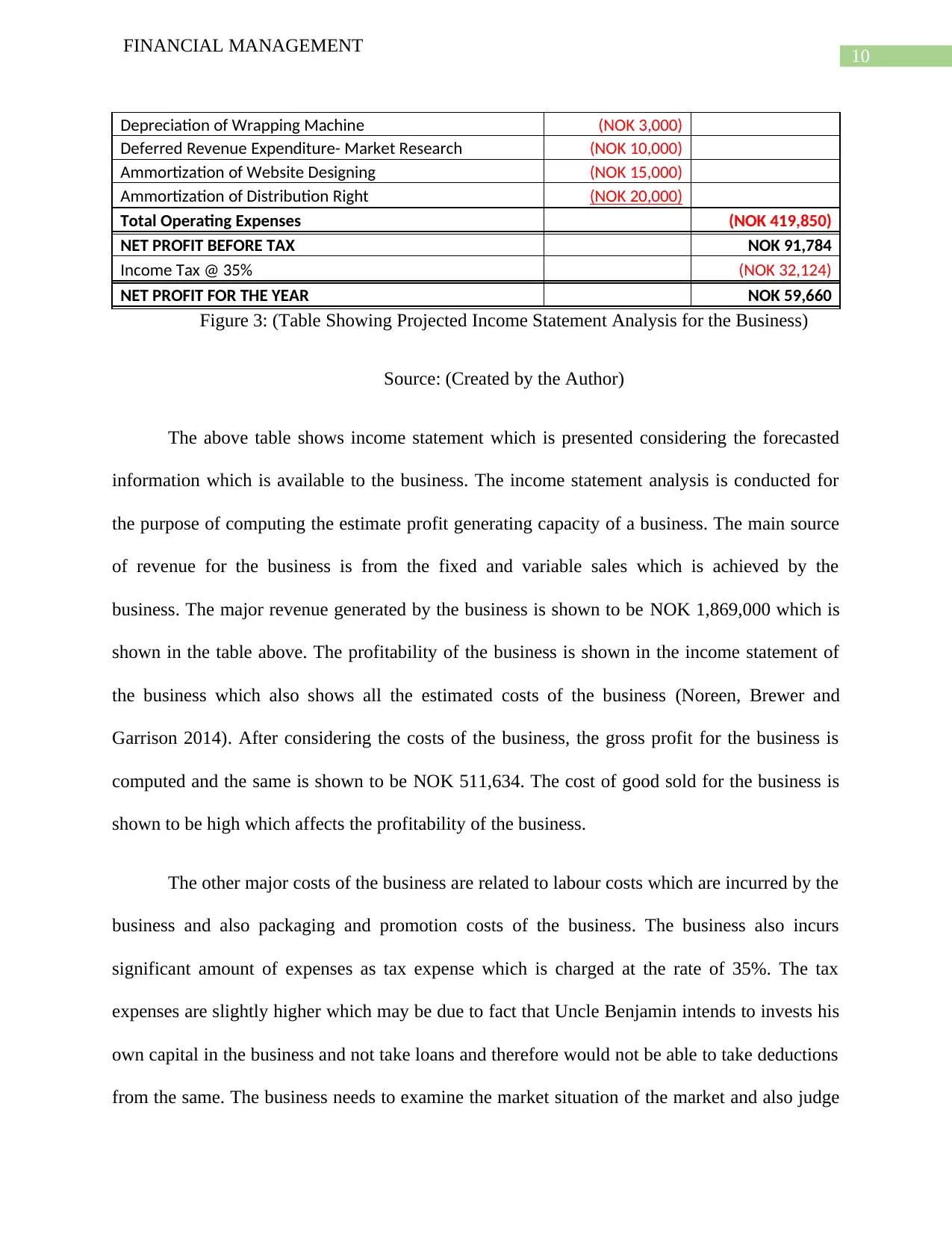
10
FINANCIAL MANAGEMENT
Depreciation of Wrapping Machine (NOK 3,000)
Deferred Revenue Expenditure- Market Research (NOK 10,000)
Ammortization of Website Designing (NOK 15,000)
Ammortization of Distribution Right (NOK 20,000)
Total Operating Expenses (NOK 419,850)
NET PROFIT BEFORE TAX NOK 91,784
Income Tax @ 35% (NOK 32,124)
NET PROFIT FOR THE YEAR NOK 59,660
Figure 3: (Table Showing Projected Income Statement Analysis for the Business)
Source: (Created by the Author)
The above table shows income statement which is presented considering the forecasted
information which is available to the business. The income statement analysis is conducted for
the purpose of computing the estimate profit generating capacity of a business. The main source
of revenue for the business is from the fixed and variable sales which is achieved by the
business. The major revenue generated by the business is shown to be NOK 1,869,000 which is
shown in the table above. The profitability of the business is shown in the income statement of
the business which also shows all the estimated costs of the business (Noreen, Brewer and
Garrison 2014). After considering the costs of the business, the gross profit for the business is
computed and the same is shown to be NOK 511,634. The cost of good sold for the business is
shown to be high which affects the profitability of the business.
The other major costs of the business are related to labour costs which are incurred by the
business and also packaging and promotion costs of the business. The business also incurs
significant amount of expenses as tax expense which is charged at the rate of 35%. The tax
expenses are slightly higher which may be due to fact that Uncle Benjamin intends to invests his
own capital in the business and not take loans and therefore would not be able to take deductions
from the same. The business needs to examine the market situation of the market and also judge
FINANCIAL MANAGEMENT
Depreciation of Wrapping Machine (NOK 3,000)
Deferred Revenue Expenditure- Market Research (NOK 10,000)
Ammortization of Website Designing (NOK 15,000)
Ammortization of Distribution Right (NOK 20,000)
Total Operating Expenses (NOK 419,850)
NET PROFIT BEFORE TAX NOK 91,784
Income Tax @ 35% (NOK 32,124)
NET PROFIT FOR THE YEAR NOK 59,660
Figure 3: (Table Showing Projected Income Statement Analysis for the Business)
Source: (Created by the Author)
The above table shows income statement which is presented considering the forecasted
information which is available to the business. The income statement analysis is conducted for
the purpose of computing the estimate profit generating capacity of a business. The main source
of revenue for the business is from the fixed and variable sales which is achieved by the
business. The major revenue generated by the business is shown to be NOK 1,869,000 which is
shown in the table above. The profitability of the business is shown in the income statement of
the business which also shows all the estimated costs of the business (Noreen, Brewer and
Garrison 2014). After considering the costs of the business, the gross profit for the business is
computed and the same is shown to be NOK 511,634. The cost of good sold for the business is
shown to be high which affects the profitability of the business.
The other major costs of the business are related to labour costs which are incurred by the
business and also packaging and promotion costs of the business. The business also incurs
significant amount of expenses as tax expense which is charged at the rate of 35%. The tax
expenses are slightly higher which may be due to fact that Uncle Benjamin intends to invests his
own capital in the business and not take loans and therefore would not be able to take deductions
from the same. The business needs to examine the market situation of the market and also judge
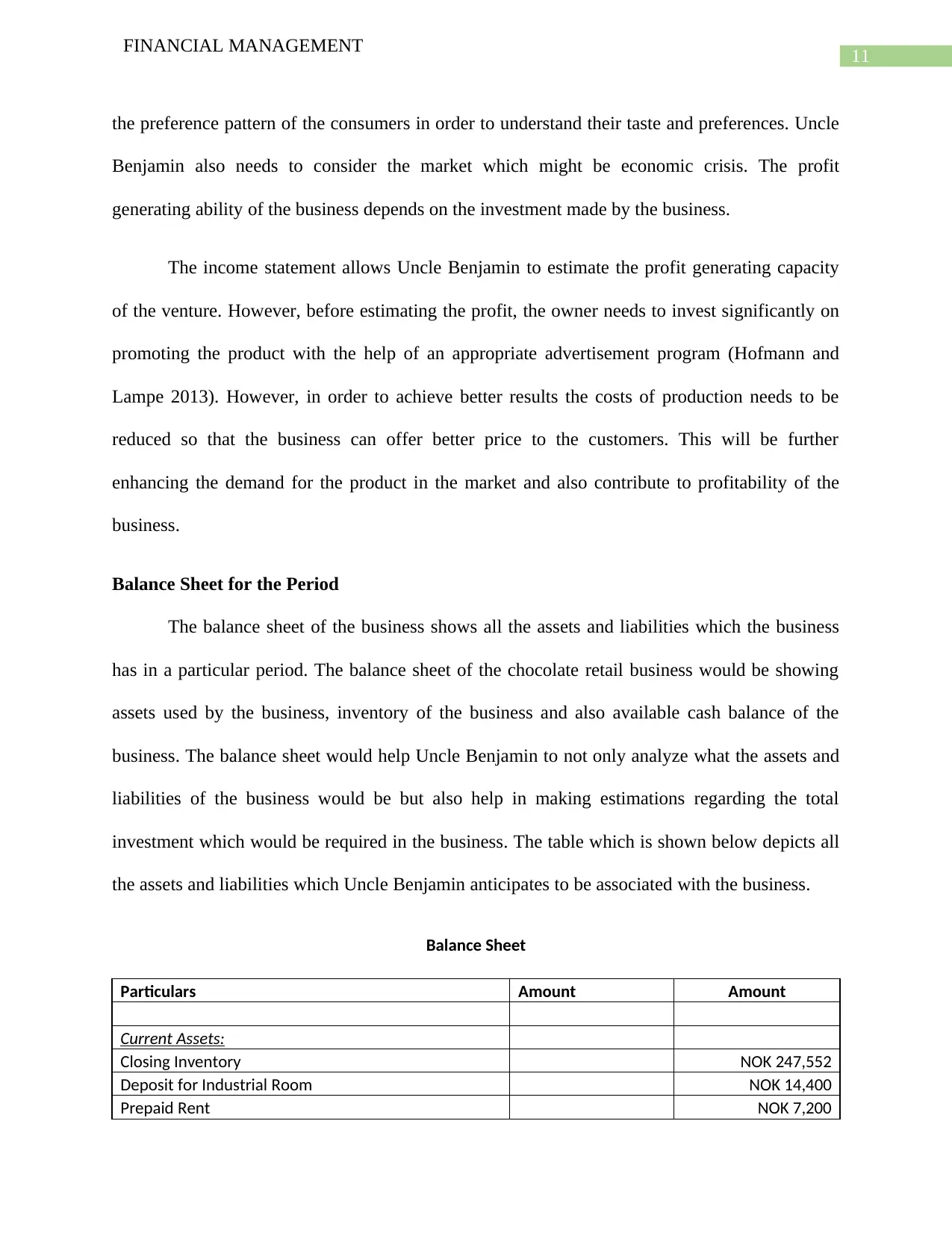
11
FINANCIAL MANAGEMENT
the preference pattern of the consumers in order to understand their taste and preferences. Uncle
Benjamin also needs to consider the market which might be economic crisis. The profit
generating ability of the business depends on the investment made by the business.
The income statement allows Uncle Benjamin to estimate the profit generating capacity
of the venture. However, before estimating the profit, the owner needs to invest significantly on
promoting the product with the help of an appropriate advertisement program (Hofmann and
Lampe 2013). However, in order to achieve better results the costs of production needs to be
reduced so that the business can offer better price to the customers. This will be further
enhancing the demand for the product in the market and also contribute to profitability of the
business.
Balance Sheet for the Period
The balance sheet of the business shows all the assets and liabilities which the business
has in a particular period. The balance sheet of the chocolate retail business would be showing
assets used by the business, inventory of the business and also available cash balance of the
business. The balance sheet would help Uncle Benjamin to not only analyze what the assets and
liabilities of the business would be but also help in making estimations regarding the total
investment which would be required in the business. The table which is shown below depicts all
the assets and liabilities which Uncle Benjamin anticipates to be associated with the business.
Balance Sheet
Particulars Amount Amount
Current Assets:
Closing Inventory NOK 247,552
Deposit for Industrial Room NOK 14,400
Prepaid Rent NOK 7,200
FINANCIAL MANAGEMENT
the preference pattern of the consumers in order to understand their taste and preferences. Uncle
Benjamin also needs to consider the market which might be economic crisis. The profit
generating ability of the business depends on the investment made by the business.
The income statement allows Uncle Benjamin to estimate the profit generating capacity
of the venture. However, before estimating the profit, the owner needs to invest significantly on
promoting the product with the help of an appropriate advertisement program (Hofmann and
Lampe 2013). However, in order to achieve better results the costs of production needs to be
reduced so that the business can offer better price to the customers. This will be further
enhancing the demand for the product in the market and also contribute to profitability of the
business.
Balance Sheet for the Period
The balance sheet of the business shows all the assets and liabilities which the business
has in a particular period. The balance sheet of the chocolate retail business would be showing
assets used by the business, inventory of the business and also available cash balance of the
business. The balance sheet would help Uncle Benjamin to not only analyze what the assets and
liabilities of the business would be but also help in making estimations regarding the total
investment which would be required in the business. The table which is shown below depicts all
the assets and liabilities which Uncle Benjamin anticipates to be associated with the business.
Balance Sheet
Particulars Amount Amount
Current Assets:
Closing Inventory NOK 247,552
Deposit for Industrial Room NOK 14,400
Prepaid Rent NOK 7,200
⊘ This is a preview!⊘
Do you want full access?
Subscribe today to unlock all pages.

Trusted by 1+ million students worldwide
1 out of 30
Related Documents
Your All-in-One AI-Powered Toolkit for Academic Success.
+13062052269
info@desklib.com
Available 24*7 on WhatsApp / Email
![[object Object]](/_next/static/media/star-bottom.7253800d.svg)
Unlock your academic potential
Copyright © 2020–2025 A2Z Services. All Rights Reserved. Developed and managed by ZUCOL.





